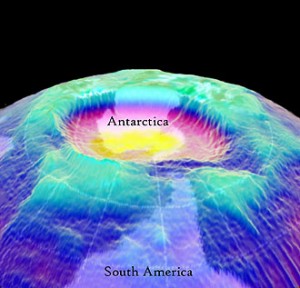New Ozone Hole Discovered over the Arctic
Tuesday, December 20th, 2011 7:00:11 by Fayyaz Yaseen
New Ozone Hole Discovered over the
Arctic
For the first time, scientists have identified an ‘ozone hole’ over the Arctic, in addition to the well-known ozone hole over the Antarctic. Unusually persistent low temperatures over the arctic in early 2011 caused an unprecedented
amount of chemical destruction of stratospheric ozone there. The authors warn that this is likely to happen again, although it is presently difficult to predict when this might be.
Ozone depletion occurs naturally each year in the Arctic and the Antarctic when low temperatures in winter cause polar stratospheric clouds (PSCs) to form. These clouds help convert harmless forms of chlorine (chlorine nitrate
and hydrogen chloride) into more reactive forms that destroy ozone (chlorine monoxide). Normally, annual Arctic ozone loss is small compared to that in the Antarctic, but in early 2011, this study found that it was far greater than ever seen before in the
Arctic, and the amount of ozone that was destroyed was comparable to that in some Antarctic ozone holes.
The scientists measured ozone loss over the Arctic using instruments attached to observation balloons and a satellite orbiting the Earth. Despite some uncertainty over precise levels of ozone depletion, the scientists estimate
that 80% of Arctic ozone in the 18-20 km altitude range was lost between January and late March 2011. The chemical ozone loss was nearly double that in 1996, 2000, and 2005, the years with the next highest Arctic ozone depletion.
According to the study, which was partly supported by the EU RECONCILE project, the unprecedented ozone loss in the Arctic was mainly caused by an unusually long period of low stratospheric temperatures (over the Arctic) that persisted
from December through the end of March, much later than in other years. The low temperatures also extended over a larger altitude range (height above the ice sheet) than previously. Together, these factors led to a higher volume of PSCs forming over a longer
time period, causing greater ozone loss than usual.
A long-term trend towards decreasing stratospheric temperatures in the Arctic means that an ozone hole is likely to appear again, say the scientists, but huge differences in winter conditions from year to year make it extremely
difficult to predict when this might be. For example, the last decade has seen four of the warmest Arctic winters in the past 32 years and also two of the coldest. The variability in Arctic temperatures is also affected by increasing greenhouse gas emissions,
which further complicates predictions.
Although the Arctic ozone hole in 2011 was confined to a smaller area than the Antarctic hole, there are concerns that if one occurs in the future, it may reach parts of the well-populated mid latitudes, as it did briefly in 2011,
increasing the risk of mass exposure of people, plants and wildlife to harmful UV radiation from the sun.
In the 1980s, scientists linked the depletion of Antarctic ozone with rising levels of certain chemicals from human activity, most notably chlorofluorocarbons (CFCs). Once they are in the atmosphere, CFCs persist for many decades,
but a global reduction in CFC emissions under the Montreal Protocol has now stabilised the size of the Antarctic ozone hole.
This research highlights the importance of the Montreal Protocol in reducing atmospheric CFC levels, or the Arctic ozone hole would have become a regular occurrence long before now, even in relatively mild winters. The challenge
now is to improve the predictive power of current climate models to estimate when Arctic ozone loss might match, or even exceed, early 2011 levels.
Short URL: https://www.newspakistan.pk/?p=6720

















